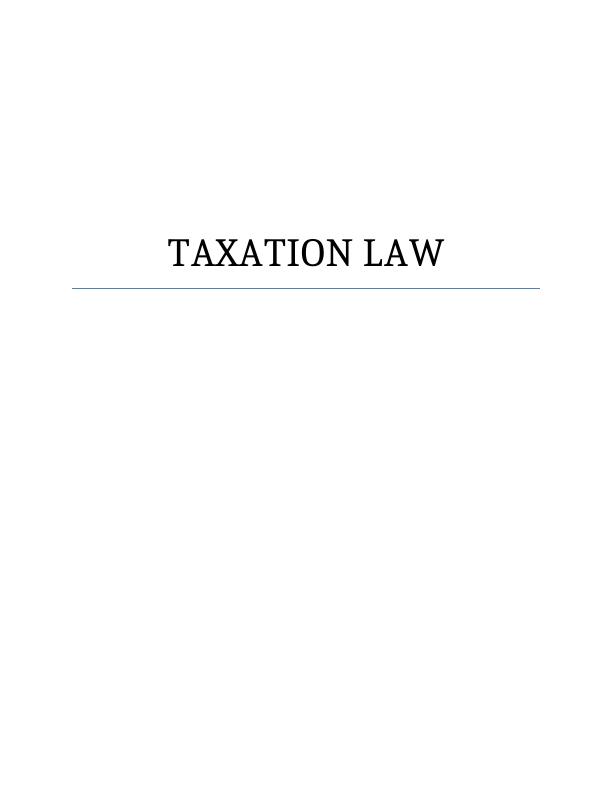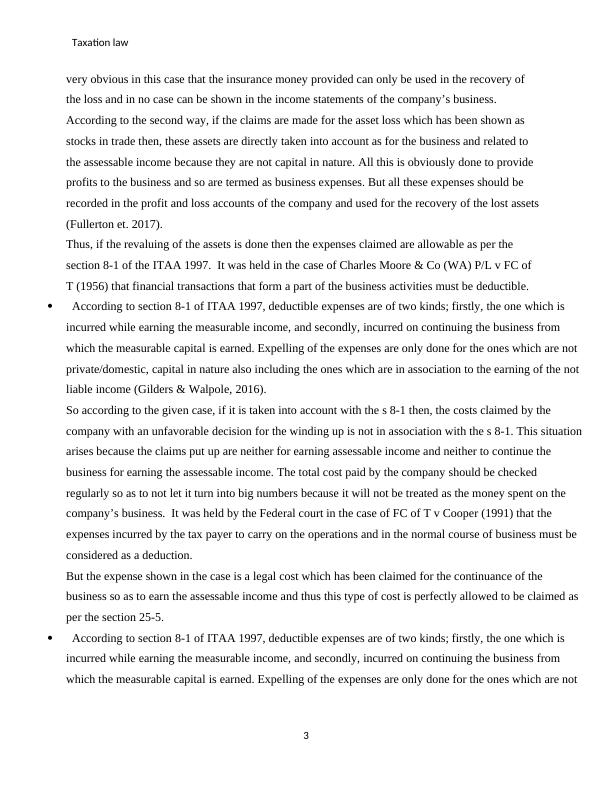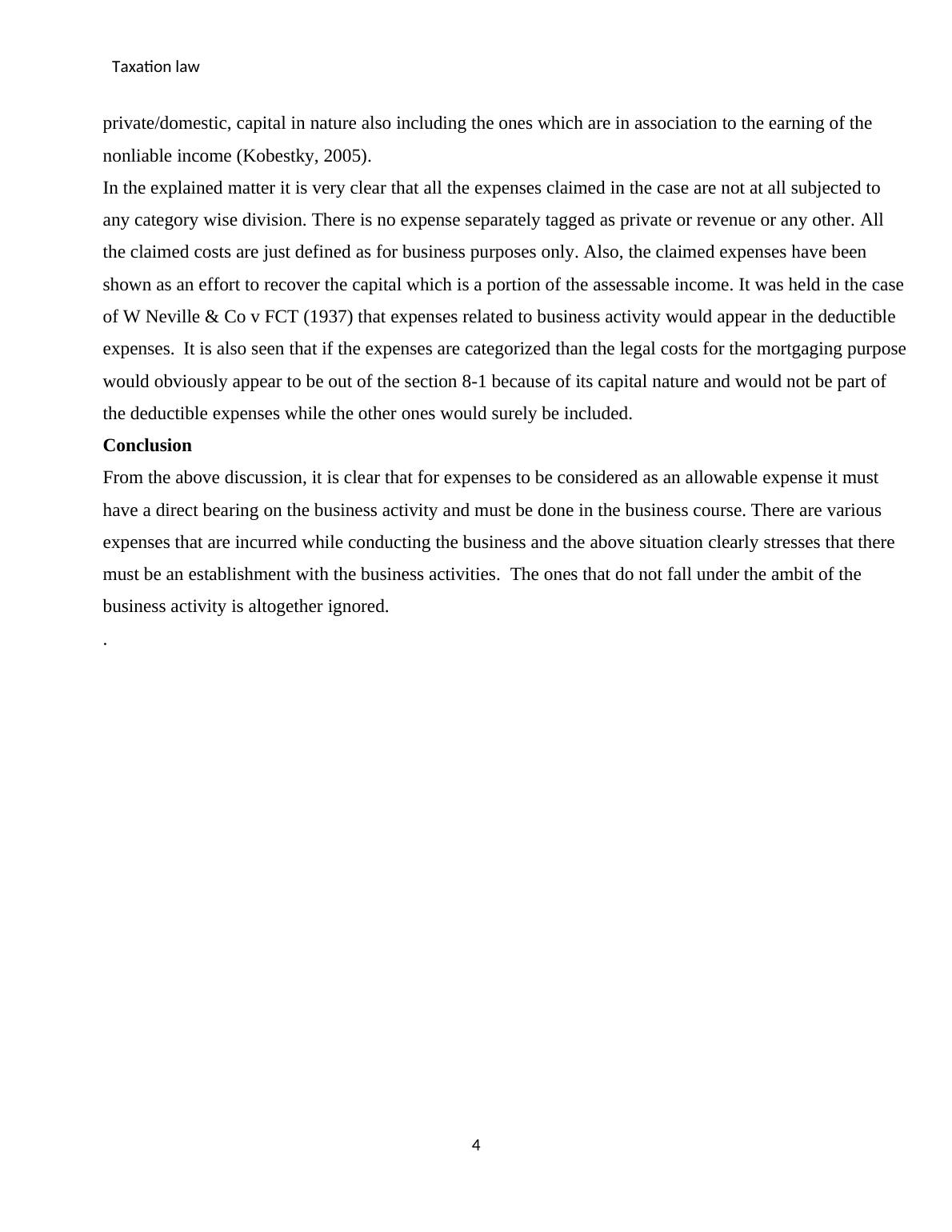Deductible expenses under section 8-1 of ITAA 1997?
Added on 2020-02-19
11 Pages2906 Words83 Views
TAXATION LAW

Taxation lawAnswer 1Issue Whether the following elements are allowed as deductions under section 8-1 of ITAA 1997?According to section 8-1 of ITAA 1997, deductible expenses are of two kinds; firstly, the one which is incurred while earning the measurable income, and secondly, incurred on continuing the business from which the measurable capital is earned. Expelling of the expenses are only done for the ones which are not private/domestic, capital in nature also including the ones which are in association to the earning of the not liable income (Pratt & Kulsrud, 2013).ApplicationThe cost of moving machinery to a new siteIt is to be noted that the expense required to purchase a new machine and to shift it from the purchasing siteto the required destination is capital in nature. This is because the shifting charge is also included in the buying cost and termed as the capital cost of machinery purchasing. This type of capital coat is never taken into consideration as per the 8-1 section of ITAA and is not treated as deductible expenses. The expenses spent on the machinery shall always be summed up with the capital cost on the basis that it is old machinery or new machinery (Gilders & Walpole, 2016). For instance, if the machinery is new then the total costs spent on it till date shall be added to the capital cost and termed as the capital of the asset. Other expenses include transportation expenses and commissioning expenses. But considering the cost of transportation of the old machinery to a new destination, then the particular expense can be defined as a deductible expense. It was held in the case of W Neville & Co v FCT (1937) that expenses those connectedwith a business purpose must be allowed as deduction.The cost of revaluing assets to effect insurance coverThe amount spends in the revaluing the property of the company so as to claim release is only accepted if the received amount is used for regenerating the loss of income which is wholly or partially related to the assessable income of the company. Insurances can be claimed by the company only upon the rise of two cases. Firstly, if the insurance has been claimed for some machinery that has been capital in nature, and now has been destroyed by some risen situations. Inthis, the claim has been made to recover the machinery loss (Fullerton et. al, 2017). It shall be 2

Taxation lawvery obvious in this case that the insurance money provided can only be used in the recovery of the loss and in no case can be shown in the income statements of the company’s business. According to the second way, if the claims are made for the asset loss which has been shown as stocks in trade then, these assets are directly taken into account as for the business and related to the assessable income because they are not capital in nature. All this is obviously done to provide profits to the business and so are termed as business expenses. But all these expenses should be recorded in the profit and loss accounts of the company and used for the recovery of the lost assets(Fullerton et. 2017).Thus, if the revaluing of the assets is done then the expenses claimed are allowable as per the section 8-1 of the ITAA 1997. It was held in the case of Charles Moore & Co (WA) P/L v FC of T (1956) that financial transactions that form a part of the business activities must be deductible. According to section 8-1 of ITAA 1997, deductible expenses are of two kinds; firstly, the one which is incurred while earning the measurable income, and secondly, incurred on continuing the business from which the measurable capital is earned. Expelling of the expenses are only done for the ones which are not private/domestic, capital in nature also including the ones which are in association to the earning of the not liable income (Gilders & Walpole, 2016).So according to the given case, if it is taken into account with the s 8-1 then, the costs claimed by the company with an unfavorable decision for the winding up is not in association with the s 8-1. This situationarises because the claims put up are neither for earning assessable income and neither to continue the business for earning the assessable income. The total cost paid by the company should be checked regularly so as to not let it turn into big numbers because it will not be treated as the money spent on the company’s business. It was held by the Federal court in the case of FC of T v Cooper (1991) that the expenses incurred by the tax payer to carry on the operations and in the normal course of business must be considered as a deduction.But the expense shown in the case is a legal cost which has been claimed for the continuance of the business so as to earn the assessable income and thus this type of cost is perfectly allowed to be claimed as per the section 25-5.According to section 8-1 of ITAA 1997, deductible expenses are of two kinds; firstly, the one which is incurred while earning the measurable income, and secondly, incurred on continuing the business from which the measurable capital is earned. Expelling of the expenses are only done for the ones which are not 3

Taxation lawprivate/domestic, capital in nature also including the ones which are in association to the earning of the nonliable income (Kobestky, 2005).In the explained matter it is very clear that all the expenses claimed in the case are not at all subjected to any category wise division. There is no expense separately tagged as private or revenue or any other. All the claimed costs are just defined as for business purposes only. Also, the claimed expenses have been shown as an effort to recover the capital which is a portion of the assessable income. It was held in the caseof W Neville & Co v FCT (1937) that expenses related to business activity would appear in the deductible expenses. It is also seen that if the expenses are categorized than the legal costs for the mortgaging purposewould obviously appear to be out of the section 8-1 because of its capital nature and would not be part of the deductible expenses while the other ones would surely be included. ConclusionFrom the above discussion, it is clear that for expenses to be considered as an allowable expense it must have a direct bearing on the business activity and must be done in the business course. There are various expenses that are incurred while conducting the business and the above situation clearly stresses that there must be an establishment with the business activities. The ones that do not fall under the ambit of the business activity is altogether ignored.. 4

End of preview
Want to access all the pages? Upload your documents or become a member.
Related Documents
Whether the following are allowable as deductions under section 8-1 of ITAA 1997?lg...
|11
|2596
|487
HI3042 - Taxation Law - Assignmentlg...
|11
|2895
|34
Australian Taxation Law : Assignmentlg...
|9
|1296
|151
HI3042 - Taxation Law Assignmentlg...
|11
|1611
|181
(Solved) Assignment on Taxation Lawlg...
|11
|2459
|165
Assignment | Income Tax Assessment Act 1997lg...
|11
|1690
|35
